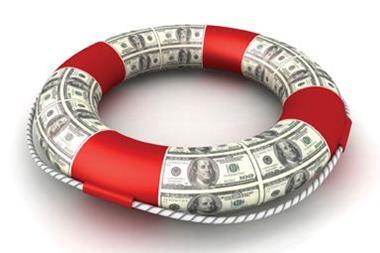Admiral Group has defied a tough economy and industry woes, posting solid results and enjoying a stellar rise in share price. But as rivals question its methods and analysts probe its strategy, how long can the company stay on an even keel?
What does Admiral know that the rest of the market doesn’t? In just 16 years, American entrepreneur Henry Engelhardt has taken the company from an obscure Lloyd’s-backed start-up to a FTSE 100 giant that is a darling of the stock market: earlier this month, shares rocketed to an all-time high of 1,700p. The company’s performance this year in a troubled motor market is remarkable, leading some to wonder: is it all too good to be true?
Eyebrows were first raised when Admiral said in its half-year statement in August that it had seen “no unusual trends in bodily injury or damage claims”. While other insurers were staggering under the body blows of personal injury claims, Admiral claimed to be unscathed. RBSI, for example, posted a £203m loss in the second quarter and IAG needed to strengthen reserves by £207m, prompting an FSA investigation into its operations.
Even smaller players, such as KGM, NIG and Esure, were feeling the pain with claims. But Admiral appeared to be going from strength to strength. Earlier this month, it reported third-quarter turnover up 50% year on year to £446m, putting it on track for another record annual profit.
Admirers believe that Admiral, an established business with a strong and seasoned leadership, is underpinned by a robust business model and is poised to take advantage of hardening motor rates. The sceptics, however, are looking at the wider industry experience and asking how much longer this insurer can defy gravity.
The mechanics of success
Let’s go under the bonnet of Admiral Group. It operates from a low-cost base in Cardiff, Wales, employing 2,700 staff, and it is made up of a range of brands that target different UK drivers. Admiral focuses on young drivers, Diamond targets women, Elephant is a multi-personal lines insurer, Gladiator attracts van drivers and Bell scoops up motorist with good claims history.
The group runs operations in five different countries – Spain, Italy, Germany, France and the USA – and also owns aggregator Confused.com.
So that’s how it’s structured, but what about its strategy? It seems the group has a three-pronged approach. First, Admiral Group has a unique reinsurance arrangement: it underwrites just 27.5% of its premium and the rest is shared between Munich Re, Hannover Re, NewRe and Swiss Re. It has a successful arrangement in which Admiral makes money from its own underwriting share and a profit commission from the reinsurers.
Secondly, Admiral takes a careful approach to verifying the risks it takes, and stamps down on fraudulent claims. Finally, it rakes the cash in as a distributor, aggressively cross-selling ancillary products.
Admiral’s unique reinsurance arrangements mean it is a capital-light business, only reserving for its own share of the risk. Surplus capital is instead handed out in dividends – a clear attraction for investors. For the first six months of this year, it distributed 97% of after-tax earnings to shareholders, including staff.
Oriel Securities analyst Tom Dorner says: “Admiral has an extremely strong track record of delivering consistent growth since the business was set up in 1993. It has never disappointed on expectations at their results.”
The cornerstone underpinning this strong performance is claims. Admiral’s claim loss ratio was 74% against a market average of 94% last year.
It chooses the best risks, and when claims do arise, it is vigilant. Finance director Kevin Chidwick explains: “We’ve always been a very data-oriented business in terms of being a direct writer, and we’ve always been very active in terms of claims management and contacting customers quickly in the process.”
Does Admiral turn down too many claims? Chidwick says the company is in line with the rest of the market. He admits Admiral prices according to postcodes, but says it is nothing out of the ordinary.
Critics circle
Shore Capital analyst Eamonn Flanagan questions whether Admiral’s out-performance of the market is sustainable as its market share grows, however. “We are detecting increasing incredulity within the insurance industry over the group’s ability to seemingly walk on water regarding its avoidance of growing losses arising from the inexorable increase in bodily injury claims elsewhere in the market,” he says.
“While we accept that an insurer can buck the trend with a small, cherry-picked portfolio, we are much more sceptical when the insurer grows to an 8.5% market share, with 2.3 million vehicles.”
Furthermore, Admiral is fuelling its growth by taking customers from the insurers that have suffered badly in bodily injury, including RBSI and Esure. In 2009, 16.9% of new customers came from RBSI and 4.8% from Esure. These same customers could now start filing claims against Admiral.
That said, Admiral is charging these customers more: last year it was pricing around £80 above RBSI in average earned premium, giving the company a cushion. It is also well capitalised for its portion of the book, still releasing reserves above the industry average.
It’s a tricky path to negotiate, but Admiral remains confident. Its bodily injury claims frequency has been flat for several years, and overall claims have declined. Admiral only has three payment protection orders currently on its books, a liability that has drained money out of RBSI.
Chidwick says: “There’s nothing in the data that suggests we’re getting any kind of claims shock that other players have talked about.”
Excelling at the add-ons
Admiral also reckons it has cracked the toughest nut of all: aggregators. While rivals complain that price comparison sites are riddled with customers with poor claims records and prone to fraudulent claims, Chidwick thinks differently.
“One of the benefits of price comparison sites, we believe, is that you do get a very high exposure to a lot of quotes, so you can be very selective in terms of risks because you are running conversion rates that are very low, often below 1%.
“So 99 times out of 100, you can be more expensive. And because of the huge volume of price comparison sites churning through every day, that does give you a chance to grow your business quite nicely but hopefully grow it in a selective way,” he says.
Some rivals have suggested that Admiral benefits from owning Confused.com, its own aggregator. They hint that it could access pricing information gained through Confused to pitch themselves just below their competitors. But Chidwick says not.
“We’re completely at arm’s length with Confused. They come into systems and get our prices in the same way that they come into everybody else’s systems and get their prices.”
Finally, what about these ancillary products, which contributed more than half of Admiral’s £216m profits last year?
Falling under this category are profits from referrals of credit hire and bodily injury. A Deloitte review published last month showed that distributors can earn up to £300 and £700 per policy on credit hire referrals and bodily injury referrals, respectively.
Of course, this lucrative revenue pipeline is currently at risk, following Lord Jackson’s review of the claims system. The government is
currently mulling over whether to take forward recommendations to ban referral fees.There are other threats too. Although ancillary product sales have held up well, there is fear that customers will shun them if the economy remains constrained.
Despite these concerns, Admiral frustrates analysts and investors by not giving exact figures on where it earns its ancillary income. Flanagan says: “Without greater clarity on the sources of the ancillary income, we remain unable to determine the extent that Admiral’s ancillary profits are vulnerable to any downturn in the economy.”
Chidwick says the company does reveal some of the detail, but made a decision several years ago not to divulge too much information after competitors copied their ideas.
He reasons: “It’s always difficult when you are a Plc to get the balance right between disclosure at a detailed enough level so investors can decide whether they want to buy your shares or not, but not so much disclosure so you are giving away all your competitive advantages.”
The bigger they are …
As the company grows, so does its risk. Admiral is now the second-biggest player in the private motor market, and is on course for more than a billion pounds in premium this year. There may come a point when it reaches peak market share.
“We can grow quite fast and raise rates significantly. Come next year, that situation could be very different,” Chidwick says. “The market has grown very quickly, very significantly, so we may well see a tougher market next year. It might be much harder to grow.”
Ideally, the group’s international operations will pick up the slack at some point, although Chidwick says there aren’t any targets on international growth. In fact, the German operation is currently under review, but Chidwick believes that any scaling back there won’t harm their international ambitions. If Admiral can replicate its UK model in just one other country, big profits await.
So is Admiral about to hit a red light, or will it keep on cruising down the fast lane as its peers pile up on the carriageway? Having seemingly avoided the bodily injury storm, and a hardening market and potential regulation some way off, it’s likely the Admiral growth story still has some mileage left. Whatever happens, it’s a company that will continue to intrigue the rest of the insurance community. IT
Hosted by comedian and actor Tom Allen, 34 Gold, 23 Silver and 22 Bronze awards were handed out across an amazing 34 categories recognising brilliance and innovation right across the breadth of UK general insurance.













































